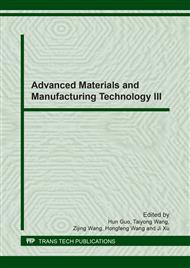p.235
p.245
p.252
p.261
p.271
p.279
p.293
p.303
p.312
Simulation Analysis of RuT450 Drilling Force Based on LS-DYNA Gun Drilling
Abstract:
Cutting force is one of the most important parameters in the machining process, it significantly influenced machining precision of the workpiece, power consumed in the machining process, wear of the cutting tools and so on. There are many factors that affect the cutting force, such as the performance of the workpiece material, cutting speed, usage of the cutting fluid, etc. Single factor variable method was used in this paper, RuT450 was used as workpiece, welded cemented carbide gun drill was used as cutting force and LS-DYNA was used as simulation platform to established the cutting simulation model to analyzed the impact of the cutting speed and feed rate to the drilling force. Simulation results show that, at the low speed drilling stage, drilling force increases with the increase of the feed rate and decreases with the increase of the rotation feed, from the stress cloud it could be seen that the equivalent stress near the drill tip reached the maximum in the drilling process.
Info:
Periodical:
Pages:
271-278
Citation:
Online since:
February 2018
Price:
Сopyright:
© 2018 Trans Tech Publications Ltd. All Rights Reserved
Share:
Citation:


